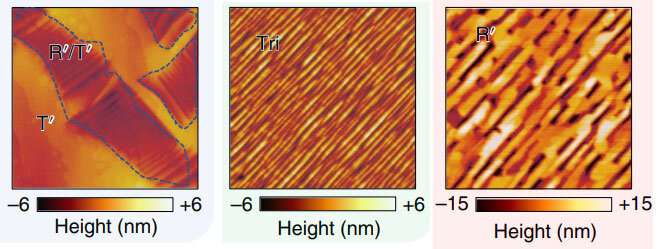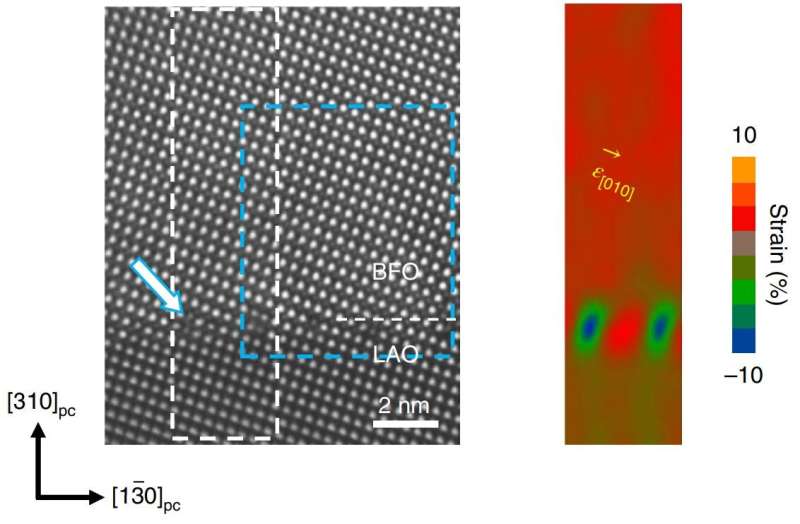Enhancing piezoelectric properties under pressure

Stress enhances the properties of a promising material for future technologies.
UNSW researchers have found a new exotic state of one of the most promising multiferroic materials, with exciting implications for future technologies using these enhanced properties.
Combining a careful balance of thin-film strain, distortion and thickness, the team has stabilized a new intermediate phase in one of the few known room-temperature multiferroic materials.
The theoretical and experimental U.S.-Australian study shows that this new phase has an electromechanical figure of merit over double its usual value, and that we can even transform between this intermediate phase to other phases easily using an electric field.
As well as providing a valuable new technique to the toolkit of all international material scientists working with multiferroics and epitaxy, the results finally shed light on how epitaxial techniques can be used to enhance functional response of materials for future application in next -generation devices.
Stress changes everything
If 2020–21 has taught us anything, it's that stress changes everything. Even the most "together" person can struggle and change given enough stress in their life.
The same applies for crystals, too. When we apply stress to crystals, they become strained and can change their structure and physical properties dramatically. Strain imposed on a material usually pushes together or pulls apart along (at least) one axis, creating compressive and tensile strain.
Straining thin films on substrates causes the building blocks of the film to deform to match the sizes of the building blocks of the neighboring substrate. If the structural units of the substrate are larger than those of the thin film (the blue square), the film (white outline) will stretch horizontally (i.e., "tensile strain") and compress vertically to fit.
On the other hand, a smaller substrate structure cell (green square) will cause the film structure to be compressed horizontally ("compressive strain") and stretched vertically.
"In our research, we applied anisotropic strain to our film. This means that the strain applied is different depending on which direction you're looking, and this can create complicated strain states that force films into new phases," says first author Oliver Paull (UNSW).
BiFeO3 (or BFO) boasts an impressive resume of multifunctional properties, including piezoelectricity, ferroelectricity, magnetism and optical properties.
BFO is arguably the most popular magnetoelectric material for researchers (i.e., a material that has both magnetic and electrical ordering that can influence each other).
Magnetoelectric materials are highly interesting for spintronics and memory applications since the coupling between magnetism and ferroelectricity promises low energy technologies. (Writing data with an electric field is much more efficient than writing with magnetic field.)
Not only is BFO magnetoelectric, but it is one of the very few materials that is magnetoelectric at room temperature, making it viable for use in applications such as future low-energy electronics, without the requirement for energy-intensive cryo-cooling.
Only very few multiferroic materials (i.e., materials that have both magnetic and electrical order) exhibit these useful properties at room temperature.
In addition to this, BFO boasts other functional properties: piezoelectricity, ferroelectricity, photovoltaic effects, and more. It's also lead free, giving it a clear advantage against most high-performing piezoelectric materials, which unfortunately contain toxic lead.
Piezoelectric materials, which can convert mechanical pressure into electrical energy, have wide applications as ultra-high-sensitivity sensors in devices such as smartphone motion sensors and pacemakers (where avoiding toxic materials is an advantage).
By using highly miscut substrates, the research team pushed BFO into a new phase that is essentially the link between the well-known rhombohedral-like and tetragonal-like phases.
This, coupled with the symmetry-related properties of the phase, allows it to be easily influenced by electric fields.

"We looked through the literature and found that everyone uses fairly standard commercial substrate orientations," says head investigator Daniel Sando. "We asked our providers to custom-make different miscut orientations in between the standard orientations, which led to the discovery of the new phase. We asked ourselves if the reason people hadn't done this before is that the crystallography involved with these miscuts is rather complex and can be intimidating."
The international collaboration between researchers at Oak Ridge National Lab, University of Arkansas, and Monash University, used theoretical calculations and a suite of experimental techniques to show that this new phase has a much higher electromechanical response than traditional BFO.
"We additionally show strong evidence that this low-symmetry phase can be converted into a higher-symmetry phase using an electric field, and as a result can enhance the electromechanical response even further by a factor of 3," says Oliver Paull.
A multipurpose tool: Applying the approach to a broad range of oxide materials
One of the most appealing aspects of this discovery is its general methodology and applicability to a broad class of materials systems.
"We chose to focus on BiFeO3 due to its ferroelectric, magnetic, and piezoelectric properties, but the approach is easily applied to other perovskite oxides," says Oliver Paull.
"We are currently exploring the effect of these high-index substrates on purely ferroelectric or magnetic systems, but the scope for using this technique is huge. We expect to find low symmetry phases of optically interesting materials, as well as novel domain arrangements in ferroelectrics, to name a few," noted Laurent Bellaiche, the theoretical lead on the project."
"If you're dealing with epitaxy, then this anisotropic technique could prove very fruitful for your research," says Daniel Sando.
"This study is just the beginning. We plan to combine this anisotropic epitaxy approach to oxide superlattices (repeating layers of different compositions, i.e. A-B-A-B etc.), as well as combining the low symmetry crystal structures with other established routes for improving piezoresponse, including substitution with rare earth elements, for example. Finally, since BFO is multiferroic, we have a raft of magnetic studies planned for this new low-symmetry phase." Says UNSW lab leader Nagy Valanoor.
There are even broader possible applications: Piezoelectrics used in sensors and actuators are typically lead-based compounds in bulk form. While the new approach is niche and very research-oriented, there could be scope for the new methods to work in such industries as nano-actuators or sensors. The key aspect is the use of the anisotropic epitaxy approach to 1) generate a low-symmetry phase, and 2) facilitate enhancements in response; in this case, the piezoelectric coefficient.
"Anisotropic epitaxial stabilization of a low-symmetry ferroelectric with enhanced electromechanical response" was published in Nature Materials in September 2020.
More information: Oliver Paull et al, Anisotropic epitaxial stabilization of a low-symmetry ferroelectric with enhanced electromechanical response, Nature Materials (2021). DOI: 10.1038/s41563-021-01098-w
Journal information: Nature Materials
Provided by FLEET





















